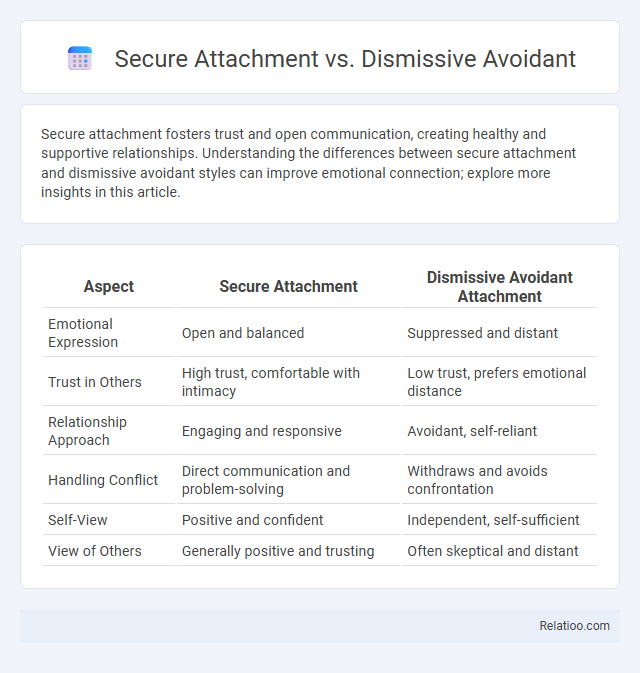Secure attachment fosters trust and open communication, creating healthy and supportive relationships. Understanding the differences between secure attachment and dismissive avoidant styles can improve emotional connection; explore more insights in this article.
Table of Comparison
| Aspect | Secure Attachment | Dismissive Avoidant Attachment |
|---|---|---|
| Emotional Expression | Open and balanced | Suppressed and distant |
| Trust in Others | High trust, comfortable with intimacy | Low trust, prefers emotional distance |
| Relationship Approach | Engaging and responsive | Avoidant, self-reliant |
| Handling Conflict | Direct communication and problem-solving | Withdraws and avoids confrontation |
| Self-View | Positive and confident | Independent, self-sufficient |
| View of Others | Generally positive and trusting | Often skeptical and distant |
Understanding Attachment Styles: Secure vs Dismissive Avoidant
Secure attachment fosters healthy emotional bonds characterized by trust, open communication, and comfort with intimacy, enabling you to form stable relationships. Dismissive avoidant attachment involves emotional distance, self-reliance, and suppression of feelings to avoid vulnerability, often leading to difficulties in connecting deeply with others. Deactivation strategies in dismissive avoidant individuals reduce attachment needs, minimizing dependence on partners and maintaining emotional autonomy.
Core Traits of Secure Attachment
Secure Attachment is characterized by emotional availability, trust, and a balanced approach to intimacy and independence. Individuals with this attachment style exhibit effective emotion regulation, empathy, and the ability to seek support during stress. In contrast, Dismissive Avoidant attachment involves emotional suppression and distancing, while Deactivation refers to the unconscious downplaying of attachment needs to avoid vulnerability.
Key Characteristics of Dismissive Avoidant Attachment
Dismissive avoidant attachment is characterized by a strong desire for independence, emotional distance, and reluctance to rely on others, often leading to suppression of feelings and avoidance of closeness. Individuals with this attachment style tend to devalue emotional connections and prioritize self-sufficiency, which can result in difficulties forming secure bonds. Understanding your tendencies toward dismissive avoidant behaviors can help you develop healthier, more secure attachments by addressing emotional deactivation patterns.
Childhood Origins of Attachment Styles
Secure attachment develops from consistent, responsive caregiving during infancy, fostering trust and emotional regulation, while dismissive avoidant attachment often originates from childhood environments where caregivers are emotionally unavailable or rejecting, leading to suppression of attachment needs. Deactivation mechanisms, common in dismissive avoidant individuals, emerge as adaptive strategies to minimize emotional dependence and vulnerability in response to early experiences of neglect or dismissal. Understanding these childhood origins reveals how early relational patterns shape adult interpersonal dynamics and emotional coping strategies.
Emotional Expression and Regulation: A Comparison
Secure attachment fosters open emotional expression and effective regulation, allowing individuals to comfortably share feelings and manage stress. In contrast, dismissive avoidant attachment is characterized by emotional suppression and discomfort with intimacy, leading to avoidance of vulnerability and reliance on self-soothing strategies. Deactivation, often observed in dismissive avoidant patterns, involves downregulating emotional responses to minimize distress, resulting in restricted emotional awareness and limited relational engagement.
Relationship Patterns: Secure vs Dismissive Avoidant
Secure attachment fosters open communication and emotional closeness, enabling Your relationships to thrive through trust and empathy. In contrast, dismissive avoidant attachment leads to emotional distancing and reluctance to rely on others, causing difficulties in forming deep connections. Deactivation, a defense mechanism common in dismissive avoidant individuals, suppresses emotional needs, resulting in a pattern of detachment and avoidance in relationships.
Communication Styles in Each Attachment Type
Secure attachment fosters open, honest communication where you express emotions and needs clearly, promoting trust and emotional intimacy. Dismissive avoidant individuals tend to minimize emotional expression, often using distancing language and avoiding vulnerability to maintain independence. Deactivation involves suppressing attachment behaviors and feelings, leading to communication that is guarded, indirect, or emotionally flat, hindering deep connection.
Challenges Facing Dismissive Avoidant Individuals
Dismissive avoidant individuals often struggle with forming close emotional bonds due to their tendency to prioritize independence and suppress feelings, leading to challenges in maintaining intimate relationships. Their deactivation strategies, which include emotional distancing and minimizing attachment needs, create barriers to vulnerability and trust, hindering effective communication and emotional connection. These patterns can result in misunderstandings, feelings of isolation, and difficulty responding to partners' emotional needs, complicating relationship dynamics.
Pathways to Building Secure Attachment
Secure attachment develops through consistent emotional responsiveness, fostering trust and emotional safety in relationships. In contrast, dismissive avoidant attachment involves emotional distancing and suppression of vulnerability as a defense mechanism. To build secure attachment, your pathway includes cultivating open communication, emotional availability, and responsiveness, which gradually deactivates avoidant defenses and strengthens trust.
Supporting Healthy Relationships Across Attachment Styles
Supporting healthy relationships across attachment styles involves understanding Secure Attachment as characterized by trust, emotional openness, and effective communication, which fosters stability and intimacy. In contrast, Dismissive Avoidant attachment, marked by emotional distancing and self-reliance, requires strategies that encourage vulnerability and enhance emotional connection. Deactivation, a defense mechanism common in avoidant styles, can be addressed through therapeutic interventions that promote awareness and gradual engagement with emotions, enabling more balanced and resilient relationships.

Infographic: Secure Attachment vs Dismissive Avoidant
 relatioo.com
relatioo.com